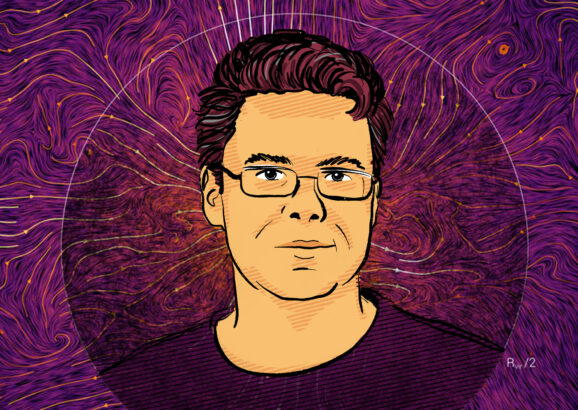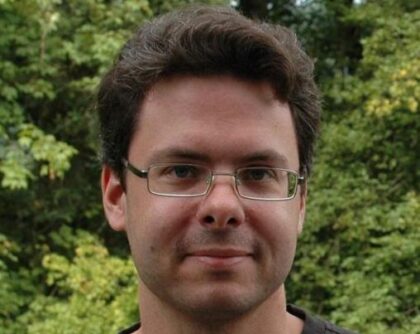Mark Vogelsberger
Research Interests
Professor Vogelsberger is a theoretical astrophysicist whose research interests broadly cover structure and galaxy formation, dark matter physics and large-scale hydrodynamical simulations. He makes extensive use of numerical simulations using state-of-the-art high-performance supercomputers around the world.
Cosmology and galaxy formation recently entered their golden age with an enormous amount of observational data becoming available. This allows detailed tests of theories of structure formation in the Universe. The combination of ever more sophisticated observations, theoretical models, and powerful supercomputer simulations have led to a better understanding of how galaxies and structure in the Universe have formed. Cosmological galaxy formation simulations play a crucial role in this process. Vogelsberger has been the main architect of the Illustris simulation, one of the most detailed galaxy formation simulation to date containing more than 40,000 galaxies whose properties closely match observational data. This simulation has been the first of its kind showing clear diversity in the galaxy population. Professor Vogelsberger is also developing new methods to extend and improve current galaxy formation models. He has been working on new numerical techniques to model anisotropic thermal conduction in galaxy clusters, radiative transfer, large-scale properties of cosmological magnetic fields, and first self-consistent models of cosmic dust within galaxy formation simulations. More recently, he has been one of the main developers of the IllustrisTNG project, the successor of the Illustris project. IllustrisTNG represents currently one of the largest and most detailed galaxy formation simulation projects.
Vogelsberger also explores dark matter scenarios beyond cold dark matter by performing and developing new simulations of alternative dark matter models. His models of self-interacting dark matter are able to solve small-scale problems of the cold dark matter paradigm while at the same time not violating any observational constraints. He has developed a new effective framework, ETHOS – effective theory for structure formation, to study alternative dark matter models much more efficiently with simulations by mapping detailed particle physics models to effective structure formation parameters. Recently, he has also presented the first detailed simulations of models of inelastic self-interacting dark matter.
Biographical Sketch
Professor Vogelsberger grew up in Germany, and received his undergraduate degree in physics from the University of Mainz and his Ph.D from the University of Munich and the Max Planck Institute for Astrophysics in 2010, advised by Prof. Simon D.M. White. In 2009 he won the Rudolf Kippenhahn Prize for his thesis work. He was an ITC postdoctoral fellow at the Harvard-Smithsonian Center for Astrophysics from 2009-2012, and a Hubble fellow from 2012-2013. In 2014, Dr. Vogelsberger joined the MIT physics faculty as Assistant Professor. In 2016 he won an Alfred P. Sloan Fellowship in Physics. Professor Vogelsberger was promoted to Associate Professor in 2018.

Mark Vogelsberger: Simulating galaxy formation for clues to the universe
“In astrophysics, we have only this one universe which we can observe. With a computer, we can create different universes, which we can check.”
Awards & Honors
- 2023 // MIT NEC Corporation Fund for Research in Computers and Communications for “Exploring the Early Universe with Supercomputer Simulations: Multi- messenger Predictions in the Era of the James Webb Space Telescope and Gravitational Wave Detections"
- 2023 // Teaching with Digital Technology Award, Nomination, MIT
- 2020 // Buechalter Cosmology Prize for work entitled “First star-forming structures in fuzzy cosmic filaments ” published in Physical Review Letters and recognized by the judging panel as “a first-of-its-kind hydrodynamic simulation that explores the interplay between ordinary matter and the wave-like interference effects of fuzzy dark matter in the first galaxies, predicting distinct signatures of fuzzy dark matter than may be within reach of detection by forthcoming missions.”
- 2019-23 // Highly Cited Researcher (Clarivate Analytics)
- 2018 // MIT Reed Faculty Initiatives Fund Award for "Constraining the Nature of Dark Matter with the James Webb Space Telescope"
- 2018 // Stamp of Honor of Deutsche Post AG for Illustris Project
- 2016 // Sloan Research Fellowship
- 2015 // MIT Reed Faculty Initiatives Fund Award for "Modeling the co-evolution of dust and galaxies"
- 2012-13 // Hubble Fellow
- 2009-12 // Harvard-CfA ITC Fellow
- 2008 // Rudolf-Kippenhahn Prize
